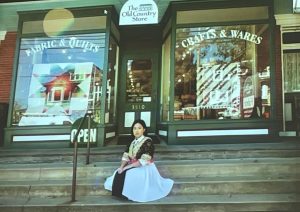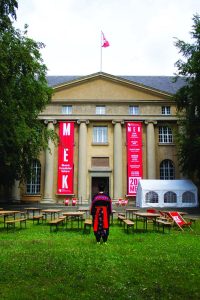‘Hnav HMoob’ project inspires
April 13, 2022
What do clothes mean to you? For some people they mean identity or a form of expression. However, the Hmong people have a different relationship with them. For them the traditional Hmong clothing is rich in culture and meaning.
Sim Naav/Hnav Hmoob: Claiming Meaning and Sisterhood Through HMoob Clothes is a project started by Kuab Maiv Yaj that engages in exploring what wearing Hmong clothes means. The presentation was shared via Zoom at UW Oshkosh on Thursday.
Maiv Yaj is a visual artist based in the Twin Cities, Minnesota who wanted to explore how dressing in traditional Hmong clothing would make her feel.

Sim Naav/Hnav HMoob presented five different Hmong women’s perspectives on traditional clothing and how it make them feel while they wear it. Victoria Kue is a featured artist, and she shows how she wears Hmong by posing in front of Amish businesses to show the intersection between the Hmong and the Amish.
Her goal was to dress Hmong every day and document this through photographs. She said that it was very isolating and that she was “alone in the west.”
“It was a powerful recognition that the everyday dress of our people are dead,” she said.
According to the event’s description, the project grew in 2021 when Maiv Yaj invited Lee Xiong, Magnolia Yang Sao Yia, Tshab Her and Victoria Kue to explore this project for the Minneapolis College of Art and Design Jerome Fellowship Exhibition in Minnesota. This event is an invitation for others to critically and consciously engage with all the artists about the politics of HMoob clothes.
Xiong presented her version of “wearing Hmong” as “a love letter to her sister.” Her pieces depicted the way she felt while wearing the clothes. Her pieces showed painful experiences in wearing Hmong.
She said that she was often made fun of for wearing Hmong clothing, and she felt like she didn’t have ownership of her body.
“Hmong clothes were not made for bodies like mine,” Xiong said.
Sao Yia is a dance artist and Ph.D. candidate in critical dance studies focused her version of wearing Hmong in the actual feeling of the clothes.
She said that she was often uncomfortable in wearing the Hmong clothing because they were hard for her to dance in. She said it was strange for her to wear Hmong clothing because when she did it felt as though she was “marked” as Hmong and written off.
She thought about the actual dressing of the clothing. She asked herself “Can I wear it however I want?”
Tshab Her is an interdisciplinary artist and wardrobe stylist. She challenged herself to wear Hmong but fused it into her everyday fashion.
She said clothing gave her a space to be seen, to be empowered and to be creative. Her goal was to bring that into this project.
“I never felt beautiful in Hmong clothes. This was a way of celebrating myself and my culture.”
Her installation was a paj ntaub, an embroidered story cloth, of her wearing the various outfits that she put together.
Victoria Kue is an interdisciplinary artist who focuses on creating objects that express her dysphoric female, Hmong-American narrative. Her take on wearing Hmong was trying to find the intersection between the Hmong and Amish.
She wore traditional Hmong clothing and took photos in front of Amish businesses in Lancaster and Intercourse, Pennsylvania. She said that this was “not a call out, but a documentation of grief” because her mother worked for the Amish.
She said she was still uncomfortable wearing the Hmong clothing, but doing the project helped her gain confidence in it.
Pacha Her is a Hmong student at UWO, and she said that the presentation meant a lot to her, especially Tshab Her’s presentation.
“She was able to express her highs and lows as well as the response that she was receiving from the public while she was doing the experiment,” she said.

She said that she understood what Sao Yia said about the clothing being sometimes uncomfortable and hard to put on, but the meaning of the people who dress you is what she loves about dressing Hmong.
“Often, it is your mother who helps you; the process of wearing Hmong clothes creates a valuable bond between mother and daughter that is irreplaceable,” Pacha Her said. “When I wear Hmong clothes it brings me peace and comfort knowing that every single piece of clothing and item I wear that makes up the Hmong outfit amplifies my Hmong identity.”
Pacha Her said, “These pieces are hand sewn to perfection [which] makes every outfit so unique and exquisite in every way; the colors make it so bold and brave, and that is exactly what wearing Hmong clothes means to me: bold, exquisite and brave.”
She said that as she has gotten older she has grown to love and appreciate Hmong clothing, but it wasn’t always easy.
“When I was young, accepting my identity as a Hmong American was a struggle. I only associated myself with the ‘American’ side of me, and it obviously had nothing to do with Hmongness or Hmong clothing,” she said. “When I was forced to wear Hmong clothes, I was embarrassed and absolutely hated it, and it wasn’t until I got older and moved away from home [that]I was able to reclaim my full identity of Hmong American.”
Pacha Her said she that never truly took the time to realize what the individual pieces meant and how they defined her.
“I truly came to my senses when I realized the hands that have intentionally created each piece of Hmong clothing were the hands that carried me, fought for me, loved me and survived a war, so I could live the life I have now,” she said. “Now, I wear the Hmong clothes with so much pride.”
She said that she could see herself incorporating Hmong clothing and modern clothing together. However, she thinks it would be hard because of how colorful the pieces are.
For more information about other Asian/Hmong heritage events happening at UWO, check out the Hmong Student Union’s Facebook page. For more information about the presenters listed, check out Magnolia Yang Sao Yia’s website MagnoliaYangSaoYia.com













